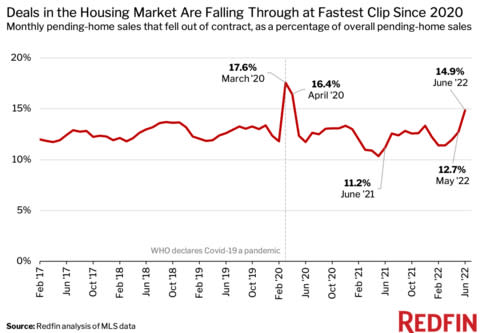Why Real Estate Is So Hard To Price Right Now
What’s the value of a half-empty office tower in Manhattan’s Garment District? How about an aging apartment complex in a Phoenix suburb?
In the dark art of valuations, industry pros rely on comparable sales to put a price on real estate. But higher interest rates have led to fewer deals, obscuring an already murky view for brokers, lenders and developers.
New York City office sales are down nearly 50 percent from last year, according to Avison Young. New York multifamily sales this summer fell to their lowest level since the Federal Reserve started raising interest rates in March 2022, Ariel Property Advisors reported.
“It’s going to be an absolute bloodbath.”
Michael Comparato, Benefit Street Partners
“Nobody has a good sense of value,” said Alex Horn, managing partner at Miami-based lender BridgeInvest. “Everyone is operating on what has happened in the past.”
While any appraisal requires some magical thinking — predicting things like income, occupancy and economic cycles — the decline in transactions has made the guessing game particularly difficult.
As a result, dealmakers are avoiding office spaces and instead looking at more stable asset classes such as top-of-the-line apartment buildings and warehouses, whose valuations are clearer.
Lenders especially are focusing on metrics outside of valuations.
Chris Coiley, who heads commercial real estate for Valley Bank in New York and New Jersey, said the bank is keying in on debt service coverage ratio, a measure of whether a property is bringing in enough money to make its debt payments.
“We focus on cash flow,” said Coiley.
Appraisal game
Historically, developers and lenders have relied on appraisers for valuations.
Often employed by white-shoe commercial brokerages, appraisers traditionally operate outside of the bloodsport that is New York real estate. Instead of chasing trophy towers, throwing ice buckets or calling their partners schmucks, appraisers dwell in the real estate jargon of comps, cap rates and future ROI.
They’re a softer spoken breed. But they say their job is harder than ever.
“We need to cast a wider net when looking for comparables, going to bigger geographies, and not only looking at Class A,” said Mark Godfrey, CBRE’s head of institutional valuations. “There is more subjectivity as a result.”
Godfrey said he relies heavily on “deals that don’t close” by talking to brokers in order to gauge sellers’ expectations.
Industry sources say those expectations — not just uncertainty and the tight lending environment — are a key reason for the lack of sales. It’s sellers refusing to budge on price.
“There is a sizable gap between the expectations of buyers and sellers,” said Jonah Sonnenborn, head of real estate for Len Blavatnik’s Access Industries. “Until that is resolved and there is pressure to resolve that, we are going to be in this stasis.”
No one knows how long that will take. Large office owners such as Blackstone, Brookfield, and RXR have already handed lenders the keys to some office buildings, figuring they are worth less than their debt. Non-judicial foreclosures are up significantly. A recent Wall Street Journal analysis found notices for 62 mezzanine loans and other loans through October, almost double last year’s number.
But many lenders do not want to take back these assets either. Nor do they want to write down the loans and reveal properties’ eroded value.
“The seller and lender are aligned in not doing a deal to impair the equity,” said Gavriel Kahane, co-founder of the real estate private equity firm Arkhouse. “So they are both incentivized to kick the can for a better sales environment.”
The deal stasis is largely in the office sector. Demand remains strong for warehouses and logistics properties, where valuations remain high. Blackstone, which has about 40 percent of its real estate equity portfolio in the space, said vacancy rates are just 4 percent at its logistics properties. This summer, the private equity giant sold a $3.1 billion portfolio of warehouses to Prologis.
Property owners and lenders feel good about high-end multifamily valuations as well. Although some operators who bought lower-quality apartment complexes with floating-rate debt are struggling, the asset class as a whole remains stable.
Rent growth in multifamily is easier to project because demand and supply are more visible. In New York, vacancy rates are around 3 percent, the lowest in the country, according to CBRE, and the national average is only 5 percent.
Martin Nussbaum, co-founder of Slate Property Group and its lending arm Scale, which finances condominiums and multifamily, said those buyers are purchasing properties for a long-term return.
“We think that over the next five to 10 years, the interest rate environment will stabilize back to its norms, which will not be 3 percent, but it also shouldn’t be 7 or 8 percent,” said Nussbaum.
Office is the outlier. It’s not just the remote work problem and the high cost of financing, it’s that the buyer pool is almost non-existent. If investors are unsure about office valuations, banks, which are pulling back from commercial real estate across the board, are even more wary. The capital expenditures needed to make an office building competitive today are costly, making it too risky for most banks to provide financing.
Michael Comparato, the head of commercial real estate at Benefit Street Partners, said his firm stopped making office loans about three years ago.
“I don’t know how and when we get back to a place where we put a value on office buildings. You can’t value it,” said Comparato. “You are going to have office buildings worth less than zero. It’s going to be an absolute bloodbath.”
In New York, there have been just a few big-ticket office deals.
Empire Capital’s Ebi Khalili and Josh Rahmani have been the renegades, teaming up with Igal Namdar, the Hakimian family and others in the close-knit Long Island community of Great Neck to buy office buildings including 529 Fifth Avenue from Silverstein Properties and 1330 Sixth Avenue, which went for $320 million.
Read more
Also in Midtown, SL Green sold a 50 percent stake in its 47-story office tower at 245 Park Avenue to Japanese firm Mori Trust in a deal that valued the building at $2 billion.
Other than that, it’s been quiet. With the Fed keeping interest rates high, the pain will only get worse as loans mature and owners must decide whether to pump more money into their buildings or let them go.
“People ask what inning we are in,” said Comparato. “I tell them we are in pre-game stretching. I don’t even think this thing has started yet.”



